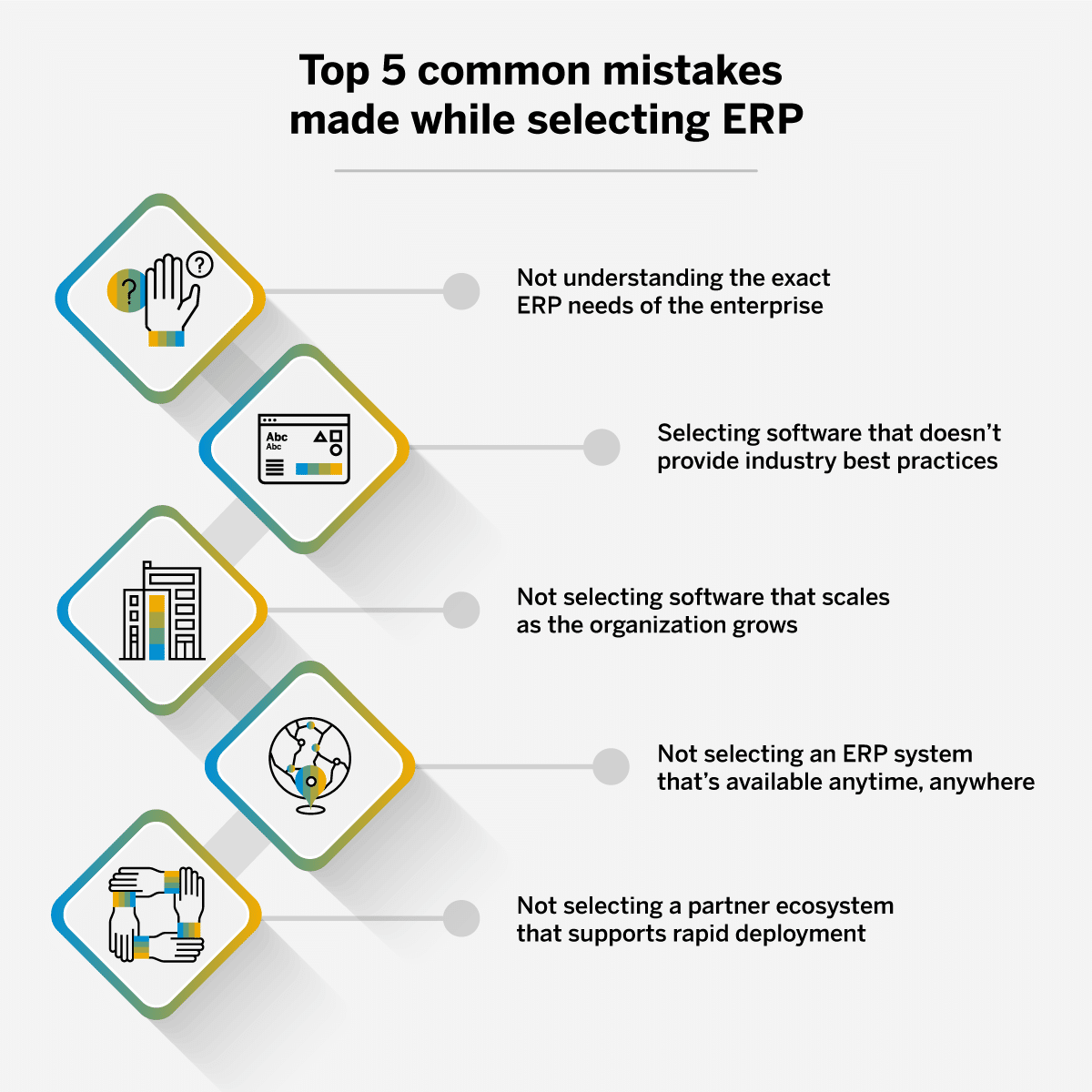One of the most significant technologies that any company can deploy is an Enterprise Resource Planning (ERP) system, designed to capture all information about customers and business activities. Research indicates that the worldwide ERP market is projected to reach $86,303 million by 2027. Leveraging an SAP ERP system can yield multiple business results and pave the way for data-based innovation. Small- and medium-scale enterprises are also embracing ERP tools to gain a competitive edge and shift from a ‘survive’ to a ‘thrive’ mode. And for good reason.

The benefits of ERP systems span business operations and processes. According to a recent report, around 49% of companies said they improved all business processes post ERP implementation. A business-aligned ERP system can assist MSMEs in:
- Integrating processes and workflows across the organization to boost productivity
- Moving beyond automation to contextual and role-based autonomy
- Scaling operations sustainably, flexibly, and strategically
- Solving business problems and altering core capabilities to boost revenues
- Automating key processes and focusing on innovative growth opportunities as well as rapid deployment
- Connecting people, networks, and devices empowering business users to act with speed and agility, and improving in-team collaboration
- Leveraging built-in analytics for driving best practices and informed decision-making related to all aspects of the business such as HR, financials, procurement, supply chain management, and so on
However, the ERP system implementation must be done correctly. It is especially important for MSMEs because any adjustments made afterward would cost a lot of money, time, and effort. Many smaller firms are hesitant to implement an ERP system due to complexity, high maintenance costs, and increased cost of ownership. Plus, selecting the right ERP partner is as crucial as selecting the right software.
To ensure that an MSME’s ERP journey goes smoothly, it is therefore essential to understand the common pitfalls and how to avoid them.
The top 5 most common mistakes in selecting ERP systems
The implementation of ERP in any MSME helps it in moving up the value chain in terms of market credibility and stakeholder confidence. However, it is a long journey from recognizing the need for an ERP to the time it is implemented. This includes identifying company needs, budgeting for product and service procurement, evaluating various products to meet business objectives, beginning the installation process, and finally, ERP implementation. There are multiple traps to avoid on the way.
Here are some of the most common mistakes enterprises end up making when selecting an ERP system:
- Not understanding the exact ERP needs of the enterprise: To truly understand the need for ERP, it is essential that organizations conduct an internal audit of the current processes and policies. To do this, they can start by asking questions on the following five parameters:
-
- What is the employee size of the organization?
- What is the industry type?
- What is the preferred type of deployment option?
- What kind of business complexity does the organization struggle with?
- What is the expected employee growth in the coming months?
In addition to the questions mentioned above, enterprises can brainstorm on the following pointers too:
- Will the ERP software help the MSME become more competitive and improve the customer experience?
- Will it reduce informational silos and integrate disparate systems and processes?
- Can adoption of the software tool result in saved time and costs? Can it boost employee and operational efficiency?
- Will the ERP tool make the enterprise less dependent on third-party organizations?
- Will the tool help improve the business processes and drive sound decision-making?
Organizations should look at the entire length and breadth of workflows to gauge which processes can be automated. By prioritizing the processes (and important features), and charting out the core needs, enterprises can adapt and evolve at an accelerated speed with the chosen ERP system.
- Not selecting a software that provides industry best practices and covers all the business functions: A robust ERP software should come with in-built industry best practices and allow complete coordination between business functions as well as teams. Selecting a software that’s devoid of these features can lead to delays in platform deployment and prevent the business from accessing real-time analytics and business intelligence that ultimately drive productivity and efficiency. The end result would be a disjointed workflow where teams operate in silos and struggle with complex operations day-in-day-out.
- Not selecting a software that scales as the organization grows: An ERP system that does not scale with the enterprise’s needs is already setting the organization up for failure. As MSMEs grow, which they inevitably will, the ERP system should seamlessly integrate with the existing office systems. The right ERP software should assist the organization in building an end-to-end digital core–one that can help connect the people, business networks, and futuristic technologies such as Big Data, AI, IoT, machine learning, and so on.
- Not selecting an ERP system that’s available anytime, anywhere: For organizations to make the most out of their ERP system, they should be able to access it anytime and anywhere. It is essential to select an ERP system that empowers employees to access it on the go and drives greater work flexibility.
- Not selecting an experienced partner ecosystem that supports rapid deployment: When selecting an ERP software, most organizations do not factor in the need for it to be supported by an experienced partner. From on-point implementation to round-the-clock service and support, the ERP vendors should support enterprises in their unique needs. The partners should be able to provide industry-specific rapid deployment packages for a convenient and results-driven ERP implementation.

Additionally, here are a few important factors to keep in mind when selecting an ERP software:
- Create an ERP evaluation team: Do not involve too many stakeholders in the decision-making process as it can create conflicts in prioritizing requirements. Instead choose stakeholders who will directly be impacted by the software, which could comprise the CIO, IT head, developers, controllers, and so on.
- Avoid ‘ERP fatigue:’ To prevent ERP burnout, select a smaller group of people who will sit through the demos and bids. Once the team has narrowed down 2-3 options, everyone else can chip in to choose the most functional ERP software that’s in perfect alignment with the business objectives, and team goals, among others.
- Go beyond the software requirements: When evaluating an ERP software, don’t just consider the technical features, account for the expertise of the implementation team as well as the execution process. Enterprises need to partner with vendors who are experienced within their specific industry and line of business. Ideally, MSMEs should also factor in key considerations such as customizations, configurations, specialized services, and so on when choosing an ERP software vendor.
- Include additional costs: There are numerous additional costs such as the cost of the implementation partner, costs for custom requirements, project management costs, data integration costs, network structure costs, etc., that should be included within the ERP budget. According to a recent report by Panorama, organizational issues (48.3%), additional technology needed (41.4%), and data issues (39.7%) were the top three reasons why ERP budgets shoot up. These need to be kept in mind at all times and a financial buffer needs to be created for the same.
The top 5 common mistakes in implementing ERP systems
Once the right software is selected, the next step in the process is to ensure that the ERP implementation is strategic. Without investing the right kind of time, resources, and money, an ERP implementation can fall between the cracks and lead to cost overruns, lost productivity, and unnecessary delays. Here are five mistakes to avoid when implementing an ERP software:
- Not calculating the time and resources required accurately: Integrating an ERP system is not a one-person job. It requires extensive effort from all the key stakeholders involved. As a result, organizations must accurately estimate and provision for the time and resources required. One way to calculate the time needed is to divide the cost of the software by 100. For instance, a $10,000 software will need 100 man-hours to be implemented effectively. And it is advisable to leverage professional help instead of self-implementing the software, which can cause issues later on.
- Not getting the right people on the team: Without the right talent on the team, the decision-making process can become flawed or derailed. It is a common blunder that many organizations remain laser-focused on getting approvals, instead of building a diverse team of stakeholders from varying functions such as operations, manufacturing, finance, marketing, and IT. Setting up an ERP will work as well as the people driving the process. By involving the team members early on in the process, enterprises can benefit from an active and highly-engaged team.
- Not investing in training and change management efforts: To drive successful ERP execution, the team members need to be comfortable with the software before it goes live. Not establishing a proper training mechanism and a line of communication will prevent employees from using the software to its full potential. After all, irrespective of the ERP software chosen, every tool comes with a certain learning curve that employees must understand. Organizations should also focus on creating a change management program to enable seamless ERP implementation, keeping in mind the following best practices:
-
- Focus on getting stakeholder buy-in and maintaining engagement as well as awareness by analyzing their mindsets, aspirations, and goals
- Assess how the ERP project will impact other business operations
- Hold workshops with employees to understand their goals and how it can align with the ERP project
- Conduct a wide-ranging training strategy which includes end-user testing by way of classes, workshops, and practical sessions
- Not setting realistic expectations and taking the kitchen sink approach: It is understood that an ERP system can solve key operational issues, but one system cannot help managers manage a business end-to-end. Thus, managers should set measurable and realistic expectations. Ideally, the leaders should focus on adopting an ERP software to track costs and optimize key milestones within the value chain.
- Not vetting the ERP vendor properly: An ERP vendor’s job is not simply to implement the software and call it a day. They need to educate the team on the functionalities and capabilities of the software. This means putting in extra effort into training and offering added support even after If the client’s team is unable to get an in-depth understanding of key features, the software becomes pointless. It can lead to missed opportunities and an inability to meet business goals. One way of ensuring that you are partnering with a suitable vendor is to ask for references and client testimonials.
There are several other critical factors to consider while implementing an ERP system. Some of them are briefly explained below:
- Ensuring proper programming and procedural parameters to reduce errors and gain accurate data that can be fed into the ERP system
- Decommissioning legacy applications so that the ERP system can streamline the workflow and reduce costs instead of adding to the issues of maintenance, hardware upgrades, etc.
- Setting up an active load test environment by simulating your user load to understand the real-world effects of the software integration
- Engaging in preventive maintenance to take full advantage of the ERP investment and ensuring that the business processes do not become obsolete
- Make sure that the ERP solution is compatible with the existing infrastructure
- Weighing the pros and cons of an on-premise versus cloud-based ERP system
The importance of having the right partner on board
Implementing an ill-aligned ERP tool is a wasted opportunity. The right resources–or a lack of these – can act as the reason for an MSME staying afloat or going down. This is why collaborating with the right partner is crucial.
With SAP ERP, leverage a 360-degree and systematic approach to ERP implementation and access a simplified execution process. With cutting-edge technology and the right people in the right places, every client of ours gets access to the highest-quality ERP deployments.



